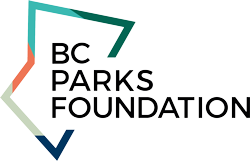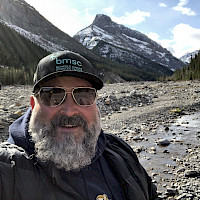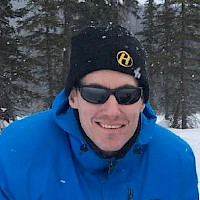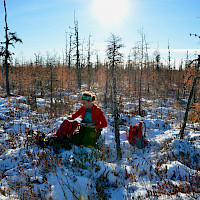About WildCAM
Introduction
Camera traps (also known as remote cameras or trail cams) are a powerful tool in modern wildlife ecology. The goal of WildCAM (Wildlife Cameras for Adaptive Management) is to support the effective management of wildlife by encouraging coordination in camera trap surveys and data synthesis. WildCAM is working to achieve this goal in five main ways: 1) creating a community of practice amongst camera trap researchers; 2) producing and reviewing best practices and tools for camera trap sampling; 3) providing a forum for coordinating wildlife monitoring across regions to improve provincial wildlife monitoring and subsequent management; 4) supporting coordinated and centralized data management, promoting data sharing and synthesis across British Columbia, Alberta, and beyond; and 5) engaging communities, stakeholders, and the public.
WildCAM aims to act as a complement to other camera trap networks and initiatives across North America by focusing on western Canada (British Columbia and Alberta).
-
The Birth of WildCAM
It's a challenging and promising time for wildlife management and conservation. Canada is rich in biodiversity, but many species are increasingly impacted by threats such as land use and climate change. With significant declines in mammals, songbirds, and other species around the world, there is renewed commitment to improve wildlife management and conservation by provincial and federal governments, First Nations, and other non-governmental stakeholders.
One of the main challenges of translating this revitalized interest into concrete policy and management decisions is a lack of reliable, large-scale data on many species of interest. At the same time, there are emerging technologies that offer promise in increasing our knowledge of wildlife and the pressures they face.
One of the tools that has increasingly come to prominence is the remote wildlife camera (also known as the camera trap). Camera traps offer a relatively cost-effective way to improve monitoring of biodiversity as well as advance research into large-scale ecological processes. Tens of thousands of camera traps have been deployed worldwide to survey a wide range of species, but individual surveys often have a small-scale focus and remain uncoordinated with other surveys, ultimately limiting their effectiveness.
WildCAM was initiated by a broad group of stakeholders at the University of British Columbia in September 2018 who discussed the creation of a province-wide camera trap network. This group included academic researchers, government biologists and managers (from federal, provincial, and municipal agencies), First Nations biologists, and researchers from non-governmental organizations. Discussions at the meeting made it clear that there were already many camera trap surveys in BC, with more planned, and that these largely independent efforts would benefit from greater collaboration and coordination. The network that has grown out of this initial meeting has come to be called WildCAM (short for Wildlife Cameras for Adaptive Management).
In 2019, staff in the Alberta Environment and Parks (AEP) Ministry formed an Alberta Remote Camera Steering Committee with leading experts on camera research from Alberta and BC, and took steps to create an Alberta Community of Practice of camera users. Many of the objectives of this work aligned with WildCAM’s vision, and in the spring of 2020, WildCAM welcomed the Alberta Community of Practice, and merged with this network to further develop the resources and opportunities of WildCAM.
-
Mission Statement
Develop a remote camera network to improve knowledge and public engagement in support of effective wildlife management and conservation in British Columbia, Alberta, Canada, and beyond.
-
Vision
Our vision is of a grassroots network driven by the needs and desires of our users, with an eye toward tackling large-scale challenges and questions too difficult for individual projects to address. We envision a robust community of practice that works as an effective means of creating and sharing knowledge within the scope of the network.
-
Objectives
-
Develop a community of practice to facilitate large-scale, collaborative collection and analysis of camera data.
-
Review and assemble best practices in remote camera survey methodologies.
-
Develop a coordinated sampling framework to address large-scale management questions and identify areas where further methodological research is needed.
-
Assess existing tools and develop new ones to facilitate effective, standardized data management and sharing.
-
Develop partnerships with diverse stakeholders and engage in public education about wildlife ecology and conservation via camera-trap images.
-
-
Who We Are
We are a broad group of partners in wildlife conservation and management working to further the study and management of wildlife through the use of camera traps. We include members from academia; federal, provincial, and municipal biologists and managers; First Nations biologists; researchers from non-governmental organizations; industry; and volunteers.
- B.C. Charter
-
Governance
WildCAM is not a legal entity. It is a collaboration comprised of network members, a steering committee, and an administrative partner (the BC Parks Foundation). The steering committee consists of experts in wildlife biology and management, wildlife cameras, and developing large-scale wildlife monitoring programs. The steering committee is responsible for establishing the direction and priorities of the program, identifying and generating resources for building program capacity, identifying and facilitating partnerships with other organizations, and providing guidance and external accountability for delivery of the programme.
WildCAM is administered by the BC Parks Foundation, an independent charitable foundation registered in Canada, in conjunction with the WildCo lab at UBC.
-
Advisory Committee
The Advisory Committee consists of:
Dr. Cole Burton (Co-Chair), Canada Research Chair in Terrestrial Mammal Conservation, Department of Forest Resources Management, University of British Columbia
Dr. Jason Fisher (Co-Chair), Adjunct Professor, School of Environmental Studies, University of Victoria
Dr. Joanna Burgar, Wildlife Biologist, South Coast Region, Ministry of Forests, Lands, Natural Resource Operations and Rural Development, British Columbia
Dr. Dan Farr, Interim Director, Environmental Science and Field Operations, Oil Sands Monitoring Branch, Resource Stewardship Division
Dr. Kaitlyn Gaynor, Assistant Professor, Department of Zoology, University of British Columbia
Dr. Anne Hubbs, Senior Wildlife Biologist, Alberta Environment & Parks
Dr. Tyler Muhly, Natural Resource Modeling Specialist, Forest Analysis and Inventory Branch, Ministry of Forests, Lands, Natural Resource Operations and Rural Development, British Columbia
Melanie Percy, Protected Areas Applied Ecologist, BC Parks, Ministry of Environment and Climate Change Strategy, British Columbia
Previous members:
Dr. Andrew Day (Co-Chair), Chief Executive Officer, BC Parks Foundation
Dr. Adam Ford, Assistant Professor, Department of Biology, University of British Columbia
-
Alberta Steering Committee
The Alberta Remote Camera Steering Committee currently consists of:
Dr. Anne Hubbs (Co-Chair), Senior Wildlife Biologist, Alberta Environment & Parks
Dr. Dan Farr (Co-Chair), Interim Director, Environmental Science and Field Operations, Oil Sands Monitoring Branch, Resource Stewardship Division
Dr. Erin Bayne, Professor - Department of Biological Sciences, University of Alberta, Director of ABMI Application Centre and Bioacoustic Unit Program, Alberta Biodiversity Monitoring Institute
Dr. Stan Boutin, Co-Research Director & President, Canadian Mountain Network, Co-Director, Science Centre, Alberta Biodiversity Monitoring Institute
Dr. Cole Burton, Canada Research Chair in Terrestrial Mammal Conservation, Department of Forest Resources Management, University of British Columbia
Dr. Jason Fisher, Adjunct Professor, School of Environmental Studies, University of Victoria
Monica Kohler, Acting Co-Director, Application Centre, Alberta Biodiversity Monitoring Institute
Dr. Tyler Muhly, Natural Resource Modeling Specialist, Forest Analysis and Inventory Branch, Ministry of Forests, Lands, Natural Resource Operations and Rural Development, British Columbia
John Paczkowski, Senior Park Ecologist, Alberta Parks, Kananaskis Region
Dr. Shannon White, Co-Director, Science Centre, Alberta Biodiversity Monitoring Institute
Jesse Whittington, Wildlife Ecologist, Parks Canada, Banff Field Unit
The Advisory Committee (formerly the BC Advisory Committee) and the Alberta Remote Camera Steering Committee have created a Memorandum of Understanding for working together.
-
Our Supporters
In addition to the volunteer and in-kind donations of our steering committee organizations and members, we are grateful for the support of the following funders:
- Teck Resources Ltd.
- BC Ministry of Forests, Lands, Natural Resource Operations and Rural Development
- BC Parks
- BC Parks Foundation
- University of British Columbia
- Canada Research Chairs
- Natural Sciences and Engineering Council of Canada (NSERC)
- United Nations Association in Canada
- Green Jobs Canada
- Mitacs
- Canadian Mountain Network (Alberta)
- Alberta Environment and Parks
If you are interested in sponsorship opportunities for the network and WildCAM projects, please contact info@wildcams.ca. You can donate directly at https://bcparksfoundation.ca/donate (select ‘Wildlife Forever’ program) or https://support.ubc.ca/projects/wildco-lab/
Advisory Committee
Highlighted Member

Kimberly Dawe
Affiliations
- Quest University Canada





